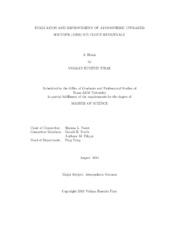| dc.description.abstract | Clouds are still one of the largest uncertainties of the current climate models. While satellites provide suitable global datasets for comparing with cloud properties derived from models, satellite retrievals are inferences of cloud properties, rather than direct measurements, and therefore have errors. Therefore, it is important to evaluate satellite cloud products and gain advanced understanding of the products to accurately interpret the observations.
This study investigates Aqua AIRS version 6 Level 2 cloud thermodynamic phase, ice cloud optical thickness, and ice cloud effective diameter, which released in April, 2013 and are available for all 13 years of the AIRS record. A filtering and gridding algorithm is used to create customized globally gridded datasets to evaluate the effects of satellite's viewing zenith angle, effective cloud fraction, cloud layers, cloud top temperature, time of the year, and geographic region.
Viewing zenith angle does not strongly affect AIRS ice-phase, but higher viewing zenith angles lead to more water and fewer unknown pixels; the viewing zenith angle dependence is not strongly affected by the time of the year. Higher effective cloud fraction yields more ice- and water-phase, and less unknown-phase retrievals. Also, higher effective cloud fractions lead to greater values of ice cloud optical thickness. In addition, especially in high latitudes, ice-phase frequency is greater for two-layer clouds than single-layer clouds. On the other hand, water- and unknown-phase frequencies are greater for single layer clouds. Also, higher viewing zenith angles slightly decrease upper cloud top temperature. Approximately 90% of ice-phase cases have upper cloud top temperature values between 210 K and 235 K, ~80% of water-phase cases are found at 243-273 K upper cloud top temperature interval, and ~80% of the unknown cases have upper cloud top temperature values between 230 and 264 K. For ice cloud optical thickness and ice cloud effective diameter, no strong effects of satellite viewing zenith angle or cloud layering are observed. | en |


